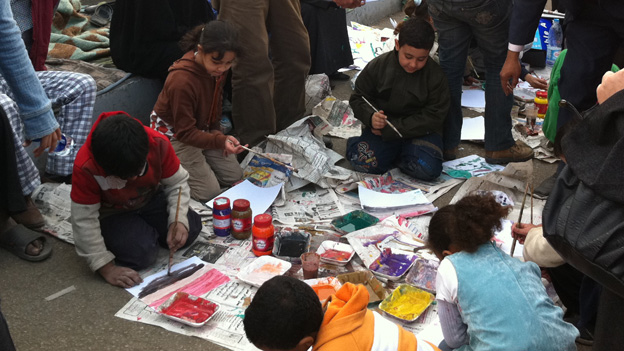photography
Telling Stories with Photographs
Leigh Vogel, a professional photographer, working with the Center for Social Impact Communication at Georgetown has published an excellent little primer on the use of photography by NGOs:
Images can play a vital role in how effectively messages can reach various audiences. When images accompany text or a story, which element makes the difference in engaging the reader or viewer? Which motivates one to act? Using images strategically in external and internal communications planning and execution can be a vital component of success for an organization.
In addition to “reading” photos, topics include legal rights, photo sharing and distribution, and managing your archive.
Page through below or download as a PDF. (via)
Tahrir, Revolution, and Design
Stunning photos today of the millions of Egyptians out in the streets to commemorate the start of the revolution a year ago that turned out Mubarak — and to demand transition from military to civilian rule.
A few things have been written on the supporting role of design in the revolution and the urban landscape as both site and medium of protest:
- The role
of protest signage
- Graffiti and murals
- Planning, public squares and cities as tools of rebellion
- Flyers, manifestos and ephemera
- Cellphone cameras and social media
- Even product labeling.
But I think my favorite detail is in this annotated overview of Tahrir square by BBC News.
The authors of direct action (particularly in West Asia and North Africa) are often depicted as a rowdy mob of thugs. But instead of the usual sea of angry Arab men so often shown by the mainstream media, the photo shows a kindergarten set up in the square. Schools in Cairo had been closed during the protests, but many mothers wanted to attend the demonstration as well. So demonstrators organized an impromptu kindergarten.
The image captures the spirit of mutual support that sprang up around the occupation. And my favorite detail: the newsprint under the paintings to keep the square, the city and country they love, free from spills. No random acts of violence here, but using the city to create something new, a different future, with hope and love.


Have You Seen This Child?

Despite Apple’s high-profile use of figures like Martin Luther King, Jr and Ghandi in their Think Different ad campaign, I find Apple’s profiles of pro users fairly conventional.
The profile of Seamus Conlan, however, is a bit more socially engaged:
In Rwanda in 1994 covering a notoriously lethal civil war, photojournalist Seamus Conlan found himself suddenly and unexpectedly reassigned, not by a magazine or newspaper editor, but by his conscience. “I was working in Rwanda as a freelance photographer doing documentation on the lost children, a very big problem and a huge story,” says Conlan. “As I was riding in the back of a truck, photographing the orphans and collecting them at the same time, I decided to take a photo of every child as a means of tracing them.”
Conlan dropped out of photojournalism to complete his self-assigned new mission, photographing 21,000 orphans over a period of a year and a half. But because the children were known by ambiguous names such as Child of Hope or No Man Should Dishonor Me — “There were no John Smiths” — Conlan completed his tracing solution by posting the photographs on billboards sorted by place of origin. “If a child came from Kigali, the parents would go to that billboard, point to the child, give the ID number to the Red Cross and take that child home.”
Conlan’s photographic tracking method is now used by all major relief agencies.
See this 2006 piece on CNN, Camera reunites Rwandan children, families, and Seamus’s own site.
 “In our attempt to bring this story [about the war in eastern Congo to access gold deposits] to the attention of these international gold traders, Human Rights Watch and I worked together to create an exhibit of my mining photographs in Geneva, Switzerland, where Metalor Technologies, one of the leading gold mining companies, has its corporate offices. We invited to the exhibit’s opening night gold buyers and mining company executives as well as financiers, stockholders and journalists. Immediately after seeing this exhibit, Metalor Technologies halted its purchases of Congolese gold.…
“In our attempt to bring this story [about the war in eastern Congo to access gold deposits] to the attention of these international gold traders, Human Rights Watch and I worked together to create an exhibit of my mining photographs in Geneva, Switzerland, where Metalor Technologies, one of the leading gold mining companies, has its corporate offices. We invited to the exhibit’s opening night gold buyers and mining company executives as well as financiers, stockholders and journalists. Immediately after seeing this exhibit, Metalor Technologies halted its purchases of Congolese gold.…At about the time I was teaching these young students, I was collaborating with a comic artist, Paul O’Connell, on an article for Ctrl.Alt.Shift. Our partnership revolved around the idea of us combining our various skills to create new ways of delivering messages. What this meant is that Paul took my photographs from places like the Congo and transformed them into a comic strip to tell the story to a different audience.” (via)

